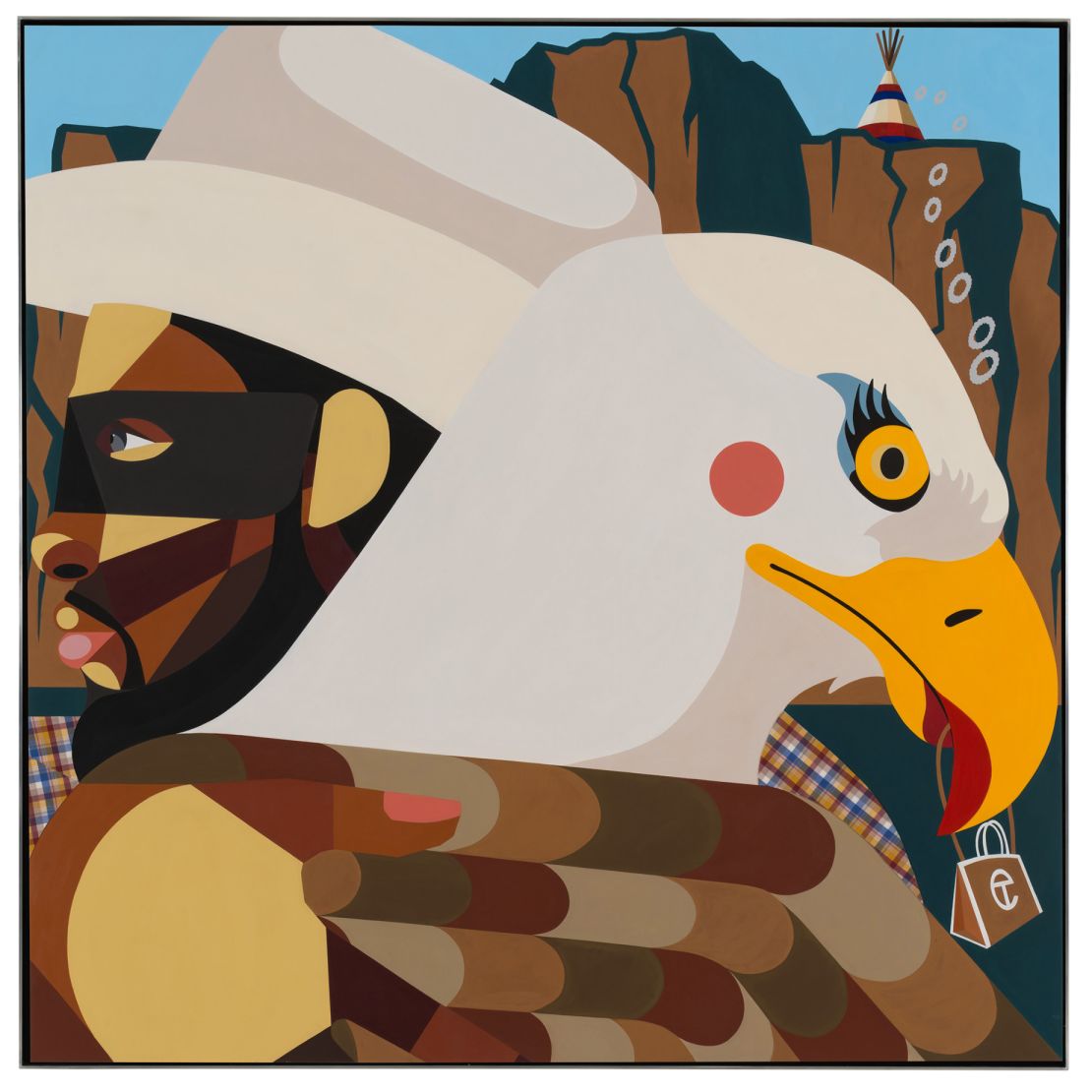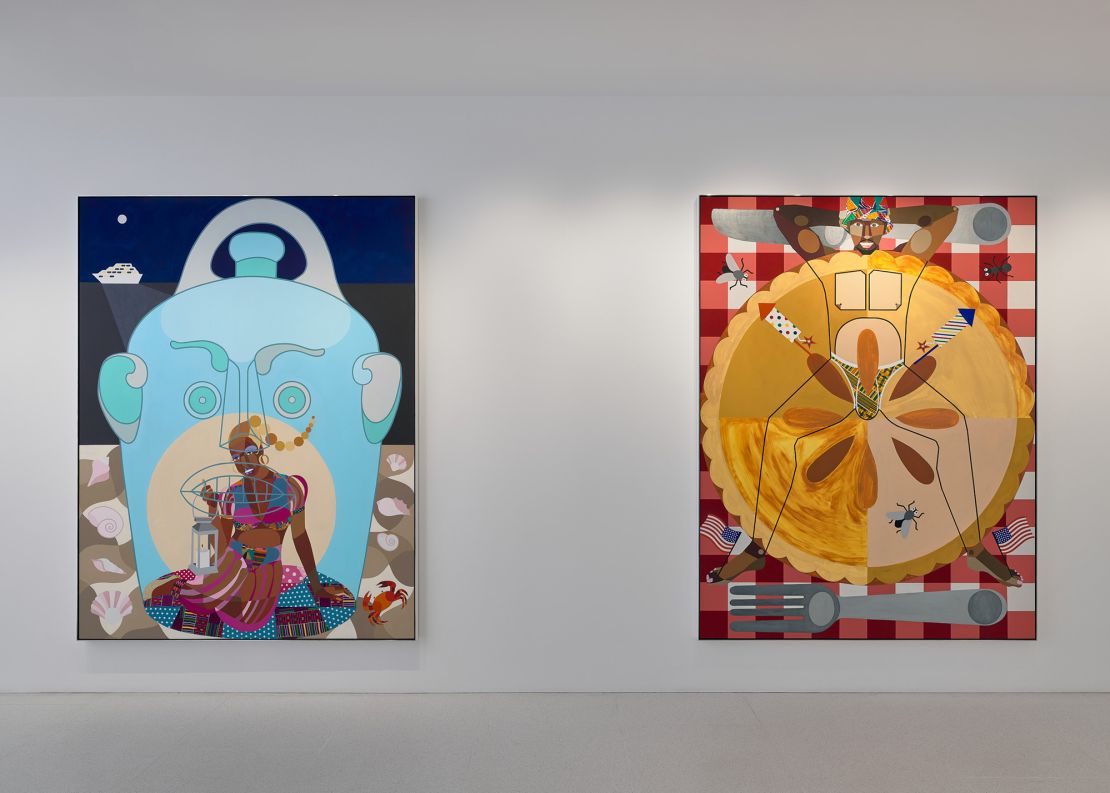In “Situation Comedy,” on show at the Gagosian Gallery in London, running until March 22, it’s all too easy to fall into the trap of politicizing Adams’ work. Is the floating girl sporting the afro made from Tootsie Rolls in “Only Happy Thoughts” (2024) a visual innuendo referencing a racial slur? Could the Black cowboy picture in “Getting the Bag” (2024) be a comment on an oft-forgotten part of African-American history? (While popular culture would have you believe ranching and horse riding were exclusively the domain of White men, historians estimate that one in four cowboys during the 1900s were Black). They could be. But they could also be exactly what you see — vibrant, larger-than-life figures in playful compositions with prismatic skin tones. Crucially, Adams says, it is up to you.
“I like the idea of letting things flow through me in a way that’s more intuitive and allowing people to rummage through it and pick out things that resonate with them,” he said.

‘It allows people to have an escape’
For Adams, who was born in Baltimore in 1970, painting is a way of “bookmarking” his interests and fixations: Telfar bags, 19th-century ceramics, Kenyan Masai warrior sculptures bought on 125th street in Harlem, the sky-high hairstyles of Halle Berry, and Natalie Desselle in the 1997 movie “B.A.P.S”. Some of these references are more academic than others. “(My work) has all the symbolism and all of the entry points that could make it way more complex,” he said. “But it also allows people to have an escape if they don’t want to do that.”
In his latest show, there is a focus on respite and recreation — powerful states of being that are often only afforded to those in higher socioeconomic brackets. In 2020, the Center for American Progress found that people of color were three times more likely than White people to live in areas where nature is not immediately accessible, and were therefore deprived of the health and well-being benefits that come with the ability to relax outdoors. But in Adams’ dreamlike compositions, Black figures are either in repose sleeping, having a picnic on the beach or in a forest hunting for Easter eggs.
Adams’ depiction of Black people in scenes of leisure, almost exclusively in bright colors, means his work is regularly branded as an example of “Black joy” — an increasingly popular description of Black figurative painting that doesn’t reference trauma. But Adams finds the label to be “flattened” and indicative of the pigeonholing of Black artists. “There was no real category for the work I was making,” Adams said of his early career. “People looked at it as this idea of Black joy, because I think that’s the only category they could think of… I had to fall into it, because that was an entry point to people talking about it.”

Empowering the viewer
One thing Adams is unwilling to compromise on, however, is his decision to not elucidate his work, despite his surreal configurations inviting multiple interpretations. In one image, a man wearing a bucket hat while lying on his back is baked into a 4th of July pie: the pose suggests both an allusion to Leonardo da Vinci’s “Vitruvian Man” and a playful sexual reference via a strategically placed pie vent. “(If) I explain to you what to look at… The viewer regurgitates exactly what you told them and they never go on their own (journey) of knowledge or intrigue and research,” he said. It’s an approach that one might expect from a particularly passionate art teacher (Adams is also a tenured assistant professor at Brooklyn College’s School of Visual, Media and Performing Arts).
At a Derrick Adams show, the gallery space becomes a classroom — and while there are no wrong answers, there is always scope for further reading.
In the works “Sweetening the Pot” (2024), “Fantastic Voyage” (2024), “Pot Head 1,” “Pot Head 2,” and “Pot Head 3,” (all 2025) the anthropomorphized ceramic jugs depicted by Adams pay homage to the clay pots made in the 1800s by enslaved Black potters. He remembers first encountering the vessels, as a child, when they were displayed proudly on family members’ mantelpieces. Some of his relatives’ collections were even loaned for an exhibition at the Metropolitan Museum of Art in 2023.
While the original artists remain unnamed, they are given new life in Adams’ work — a signpost to what came before. “The most successful aspect of oppression or colonialism is when the culture whose being oppressed can no longer think creatively,” Adams explained. “They can’t even think creatively because they’re so busy and set on survival… they don’t have time to imagine themselves in any other space but the space they are in. And the fact that these people, who were enslaved, dared to imagine these faces and be able to create something that was all theirs… blows my mind.”
His London show takes place during Black History Month in the US, a coincidence the artist says is “exciting”. While President Donald Trump issued a proclamation officially recognizing the commemorative month, its future seems uncertain amid the mandated rollbacks of diversity and inclusion initiatives across the country.
“Some Black artists probably would shy away from having a show during Black History Month, because they feel like they’re being pigeonholed or something. I don’t mind…” said Adams, adding that if anything, “it motivates me more.” He continued: “From my point of view, we are learning through the dismantling of things (and) what people, who are considered the most important (or are the) richest in the world, are fixated on.”

















